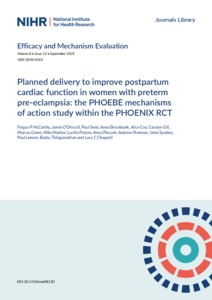McCarthy, FP;
O’Driscoll, J;
Seed, P;
Brockbank, A;
Cox, A;
Gill, C;
Green, M;
Marber, M;
Poston, L;
Placzek, A;
et al.
McCarthy, FP; O’Driscoll, J; Seed, P; Brockbank, A; Cox, A; Gill, C; Green, M; Marber, M; Poston, L; Placzek, A; Shennan, A; Sparkes, J; Leeson, P; Thilaganathan, B; Chappell, LC
(2021)
Planned delivery to improve postpartum cardiac function in women with preterm pre-eclampsia: the PHOEBE mechanisms of action study within the PHOENIX RCT.
Efficacy and Mechanism Evaluation, 8 (12).
ISSN 2050-4365
https://doi.org/10.3310/eme08120
SGUL Authors: Thilaganathan, Baskaran
![[img]](https://openaccess.sgul.ac.uk/114161/1.hassmallThumbnailVersion/3037556.pdf)  Preview |
|
PDF
Published Version
Available under License ["licenses_description_publisher" not defined].
Download (1MB)
| Preview
|
Abstract
Background
Women whose pregnancies are affected by hypertensive disorders of pregnancy, in particular preterm pre-eclampsia, are at increased risk of long-term cardiovascular morbidity and mortality.
Objectives
To investigate the hypothesis that prolongation of a pregnancy affected by preterm pre-eclampsia managed by expectant management compared with planned early delivery would result in worse cardiovascular function 6 months postpartum.
Design
A randomised controlled trial.
Setting
28 maternity hospitals in England and Wales.
Participants
Women who were eligible for the Pre-eclampsia in HOspital: Early iNductIon or eXpectant management (PHOENIX) study were approached and recruited for the PHOEBE study. The PHOENIX (Pre-eclampsia in HOspital: Early iNductIon or eXpectant management) study was a parallel-group, non-masked, multicentre, randomised controlled trial that was carried out in 46 maternity units across England and Wales. This study compared planned early delivery with expectant management (usual care) with individual randomisation in women with late preterm pre-eclampsia who were 34 weeks’ gestation to less than 37 weeks’ gestation and having a singleton or dichorionic diamniotic twin pregnancy.
Interventions
Postpartum follow-up included medical history, blood pressure assessment and echocardiography. All women had blood sampling performed on at least two time points from recruitment to the 6-month follow-up for assessment of cardiac necrosis markers.
Main outcome measures
Primary outcome was a composite of systolic and/or diastolic dysfunction (originally by 2009 guidelines then updated by 2016 guidelines, with an amended definition of diastolic dysfunction). Analyses were by intention to treat, together with a per-protocol analysis for the primary and secondary outcomes.
Results
Between 27 April 2016 and 30 November 2018, 623 women were found to be eligible, of whom 420 (67%) were recruited across 28 maternity units in England and Wales. A total of 133 women were allocated to planned delivery, 137 women were allocated to expectant management and a further 150 received non-randomised expectant management within usual care. The mean time from enrolment to delivery was 2.5 (standard deviation 1.9) days in the planned delivery group compared with 6.8 (standard deviation 5.3) days in the expectant management group. There were no differences in the primary outcome between women in the planned delivery group and those in the expectant management group using either the 2009 (risk ratio 1.06, 95% confidence interval 0.80 to 1.40) or the 2016 definition (risk ratio 0.78, 95% confidence interval 0.33 to 1.86). Overall, 10% (31/321) of women had a left ventricular ejection fraction < 55% and 71% of the cohort remained hypertensive at 6 months postpartum. No differences were observed between groups in cardiorespiratory outcomes prior to discharge from hospital or in systolic or diastolic blood pressure measurements. Variables associated with the primary outcome (2009 definition) at 6 months postpartum were maternal body mass index (adjusted odds ratio 1.33 per 5 kg/m2, 95% confidence interval 1.12 to 1.59 per 5 kg/m2) and maternal age (adjusted odds ratio 2.16, 95% confidence interval 1.44 to 3.22 per 10 years). Limitations include changing definitions regarding systolic and/or diastolic dysfunction.
Conclusions
Preterm pre-eclampsia results in persistence of hypertension in the majority of women with late preterm pre-eclampsia at 6 months postpartum and systolic dysfunction in 10%. Pre-eclampsia should not be considered a self-limiting disease of pregnancy alone.
Future work
Interventions aimed at reducing cardiovascular dysfunction.
Trial registration
Current Controlled Trials ISRCTN01879376.
Funding
This project was funded by the Efficacy and Mechanism Evaluation (EME) programme, a Medical Research Council and National Institute for Health Research (NIHR) partnership. This will be published in full in Efficacy and Mechanism Evaluation; Vol. 8, No. 12. See the NIHR Journals Library website for further project information.
| Item Type: |
Article
|
| Additional Information: |
© Queen’s Printer and Controller of HMSO 2021. This work was produced by McCarthy et al. under the terms of a commissioning contract issued by the Secretary of State for Health and Social Care. This issue may be freely reproduced for the purposes of private research and study and extracts (or indeed, the full report) may be included in professional journals provided that suitable acknowledgement is made and the reproduction is not associated with any form of advertising. Applications for commercial reproduction should be addressed to: NIHR Journals Library, National Institute for Health Research, Evaluation, Trials and Studies Coordinating Centre, Alpha House, University of Southampton Science Park, Southampton SO16 7NS, UK. |
| SGUL Research Institute / Research Centre: |
Academic Structure > Molecular and Clinical Sciences Research Institute (MCS) |
| Journal or Publication Title: |
Efficacy and Mechanism Evaluation |
| ISSN: |
2050-4365 |
| Language: |
eng |
| Dates: |
| Date | Event |
|---|
| 23 September 2021 | Published |
|
| Publisher License: |
Publisher's own licence |
| Projects: |
|
| URI: |
https://openaccess.sgul.ac.uk/id/eprint/114161 |
| Publisher's version: |
https://doi.org/10.3310/eme08120 |
Statistics
Item downloaded times since 03 Mar 2022.
Actions (login required)
 |
Edit Item |


